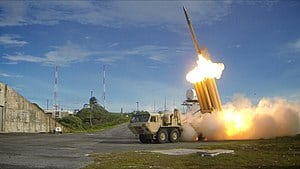by Richard Schulman

On August 30th, the US Missile Defense Agency (MDA) announced that for the first time the nation’s Terminal High Altitude Area Defense (THAAD) system was able to remotely launch an interceptor vehicle. In the words of Defense News,
[T]he Lockheed Martin-made THAAD has now had 16 successful intercept tests in a row… The ability to launch an interceptor remotely achieves a more layered — and ultimately less stove-piped — approach to regional ballistic missile defense and to increase the battle space….[A]n operator can, for instance, use a THAAD radar (which can see farther than a Raytheon-made Patriot radar) but decide to engage a Patriot interceptor depending on the threat picture.
Integration of the two area-defense systems, THAAD and Patriot — is important for defense of the Korean peninsula and US outposts in the Pacific. But this step forward in defense against North Korean threats is at the same time a bitter-sweet reminder of the more than three decades of deliberate refusal by the country’s political class to develop a continental defense of the US homeland. Such a defense would not only deter lesser threats from North Korea and Iran but also the far more consequential existential threats coming from Russia or China. And in case deterrence did fail, it would make more likely the survival of the US as a viable nation.
Countries benefiting from US deployment of THAAD and or Patriot missile defense systems include Turkey, the UAE, Saudi Arabia, Japan, South Korea, Guam, Israel, and Romania.
Couldn’t one say that the refusal to develop a continental defense for the US is a national scandal? A few weeks ago, on August 13th, Michael Griffin, head of research and engineering at the Defense Department, told a Hudson Institute audience,
[I]t has been national policy that we are not trying to defend against China and Russia, that that level of threat is a step up. But it is not a technical step up, OK? We know how to do it with existing technology. It would require buying systems that we don’t have today.It would require buying more of some of the systems we do have. So it becomes a budgetary priority. You’d be spending money on missile defense systems that we’re today spending on other things. That’s a budget priority discussion….But it is not a technical issue. We know how to do it.
Despite President Trump’s promise to establish a missile defense program that can shield “every city in the United States” and “protect the American people from all types of missile attacks,” the budget passed last March did not. “[T]here is no plan to actively defend the United States against a large-scale nuclear attack launched by Russia or China,” said Loren Thompson, an analyst with the Lexington Institute. “The U.S. will continue to rely on offensively based deterrence to minimize the likelihood of such an attack,” Foreign Policy reports.
What is urgently needed is a space-based system of sensors and interceptors to detect and destroy enemy weapons in their launch phase. That is when they are most vulnerable. A space-based system would provide continental coverage and overcome the local-area, horizon-constrained limitations of land-based detection technologies. It would also provide the battle-management capability to integrate space-based and “stove-piped” (non-integrated) land-based systems.
Some believe that President Trump has failed to prioritize the building of this critical technology:
[T]he technology for space sensors is already mature. Time is ticking by. The next defense budget will be the fourth and last of this presidential term. If the Pentagon is serious about strategic competition with Russia and China, this budget will prioritize space sensors. If not, the Trump missile defense legacy could be squandered, the new era of missile defense will not begin, and all that will be left are paper satellites.
https://www.politico.com/story/2019/09/06/opinion-missile-defense-blind-1480426
The US also needs a massive R&D and implementation effort to protect its existing space assets (satellites) against preemptive enemy attack. The Washington Examiner (4/26/2019) reports that
Russia and China reorganized their forces in 2015, putting special emphasis on countering America in space, deputy assistant secretary of defense for space policy Steve Kitay said this week during a forum at the Center for Strategic and International Studies…. The Department of Defense has been trying to spread the word about this growing threat…. [T]wo reports [here and here] offer insight into the growing threats in the military space domain. Both highlight counter-space capabilities being developed and proliferated by U.S. adversaries, including anti-satellite missiles, space-based weapons, cyber and electronic warfare, and directed-energy weapons.
Leading opponents of a space-based missile defense system include the Democratic Party’s de facto house organ, The New York Times, and the libertarian Cato Institute. They continue to argue that Mutually Assured Destruction (MAD) is more stabilizing.
Given the Democratic majority in the House, without a combined push by congressional Republicans and President Trump, it’s likely that the critical space-based sensor and interceptor layer will not be deployed, and the US population and nation will continue to be vulnerable to sudden destruction.

You need to have Facebook and Twitter links on your articles
We just looked into this and decided that adding Twitter and Facebook buttons to our content would slow down web access speed unacceptably. If a light-weight way to do this can be found, we may reconsider.
The Houthis don’t have that capability. Their suppliers and controllers, the Iranians, would like that capacity, which is why the administration deserves support for its anti-Iranian boycott and the military measures we believe are necessary in the wake of the attack on Saudi refineries. It’s also why we need a crash ABM development effort for the US homeland and allies. That’s not offensive-based deterrence but rather defensive.